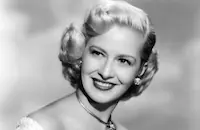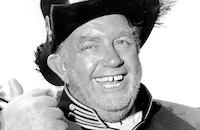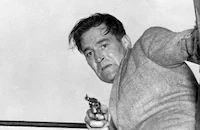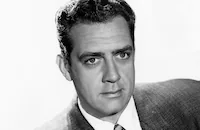New Mexico
Brief Synopsis
Cast & Crew
Irving Reis
Lew Ayres
Marilyn Maxwell
Andy Devine
Robert Hutton
Donald Buka
Film Details
Technical Specs

Synopsis
After receiving a report by Lt. Hunt about the Indian situation in the New Mexico territories, President Abraham Lincoln travels there to meet Acoma, chief of the Indian nations of the territories. They avow their friendship and shake hands to link symbolically their peoples in peace. Lincoln expresses the view that the land contains many people, but only one nation, and presents Acoma with an inscribed cane. After Lincoln's assassination, Judge Verne Wilcox, the Bureau of Indian Affairs commissioner, inaugurates a campaign against the Indians, resulting in discrimination, evictions and foreclosures. When three Indians are arrested for stealing rations at Fort Union, Hunt, now a captain, protests to the fort's commander, Col. McComb, that the rations had been withheld from the Indians illegally and warns him to release the men or face trouble. The bigoted, autocratic colonel then tells Acoma, who has come for his braves, to get out. When Acoma reminds the colonel that Lincoln gave him the authority to judge his own people, McComb knocks the cane from Acoma's hands and orders him and the three braves accompanying him arrested. When the three ride off, McComb orders his men to shoot, killing two. Acoma steps on the cane and vows revenge against McComb and Wilcox before he is taken to the jail house. McComb then arrests Hunt for attempting to countermand his orders. That night, a number of Indians sneak into the fort and kill the jail guard by striking him in the back with a hatchet. They release Acoma, who then kills McComb and warns Hunt not to follow. Hunt takes command of the fort and suspends travel west by civilians. This upsets dance hall entertainer Cherry, who is on her way to Las Vegas, but she convinces Judge Wilcox to take her west in a stagecoach. Hunt leads a small party to go after Acoma, hoping to avert a war. After five days of tiresome travel through the desert, the men grow increasingly critical of Hunt, especially when he will not allow them to fight Indians who fire on them. Hunt sees in the distance a pueblo on top of a plateau and learns from his scout Coyote that the place, called "Rock with Wings," is sacred to the Indians. Hundreds of years earlier, during a siege, the Indians held off the Spanish army with only bows and arrows and rocks; the Spanish built a church after they prevailed, but an earthquake later destroyed the only trail leading to the top. Coyote leads the men on a treacherous climb, but they find the pueblo deserted. As they are about to leave, a church bell rings, and they discover two young sons of Acoma. Pvt. Anderson, the most disgruntled of the soldiers, shoots the older boy as they try to run away and kills him. The younger boy, Chia-Kong, whom the men call "Charlie," vows revenge. Later, after the soldiers drive off Indians attacking the stage, Hunt rescues Cherry. Acoma then proposes a truce, but Hunt wants the chief to return to the fort to face punishment for the attack, which cost the lives of four soldiers. Acoma refuses and warns that the soldiers have very little ammunition, food or water left. When he learns of his son's death, Acoma demands that his younger son and the killer of his eldest be turned over to him, but Hunt says the boy is safer with the soldiers and that the killer will be punished. Judge Wilcox urges Hunt to accept the truce, until Acoma says he wants the judge also. When Hunt refuses, Acoma rides off. Hunt then orders everyone to the top of the plateau. At night, Hunt rescues Cherry from a drunken soldier, but he calls her a "parasite," causing her to break down in tears. Charlie comforts her and takes her to a secret underground spring, where guns and ammunition are hidden, but he is distressed when she insists on telling the others about the cache to avert further fighting. The judge, to save himself, convinces Charlie to lead him to Acoma, but the Indians bury the judge in sand up to his shoulders and then trample him with their horses. During the ensuing battle, Coyote is shot by other Indians, Anderson and other soldiers are killed, and Hunt is shot. Cherry carries him to the pueblo, where he sets up a fuse leading to the ammunition, which he knows Acoma plans to use for a rebellion. When he swoons, she carries him out, and he tenderly thanks her and expresses regret that he did not realize earlier what she was really like. Acoma stops his people from shooting Hunt and Cherry, then goes with his son to the room with the ammunition. As a dying soldier is about to shoot the chief and the boy, Hunt warns them, and the chief takes a bullet that otherwise would have hit his son. Hunt urges Cherry to take the boy and go, and she kisses Hunt before leaving. Acoma then grabs Hunt's hand, and Hunt smiles. The pueblo explodes and burns, but Cherry and Charlie survive and comfort each other.

Director
Irving Reis
Cast

Lew Ayres

Marilyn Maxwell

Andy Devine

Robert Hutton

Donald Buka

Ted De Corsia
Lloyd Corrigan

John Hoyt

Jeff Corey

Raymond Burr
Verna Felton
Ian Macdonald
Peter Price
Walter N. Greaza
Robert Osterloh
William Tannen
Arthur Loew Jr.
Bob Duncan

Jack Kelly
Allen Mathews
Jack Briggs

Hans Conried
Ralph Volkie
Bud Rae
Crew
Robert Aldrich
Irving Allen
Irving Allen
Irving Allen
Leon Becker
William Calihan
Glenn Cook
Evelyn Cornwell
Arden Cripe
Mac Dalgleish
Oscar Demejo
René Garriguenc
Mary Gibson
Lud Gluskin
Jack Greenhalgh
Kiva Hoffman
Wesley Jefferies
Joseph Justman
Ray Mercer
Terry Miles
Lucien Moraweck
Harry Redmond Jr.
Edward Ray Robinson
Louis H. Sackin
Paul Sawtell
John Sheets
Art Smith
William Snyder
Abe Solk
Max Trell
George Van Marter
Richard Van Opel
Gertrude Wheeler
Lester White

Film Details
Technical Specs

Quotes
Trivia
Notes
Material in the film's pressbook states that producer Irving Allen "hopes that the picture will raise a chorus of popular voices demanding that something be done for the Indian-just as such films as Home of the Brave, Gentleman's Agreement, Pinky and Lost Boundaries clamored for a square deal for their minorities." (See AFI Catalog of Feature Films, 1941-1950 for entries on the above films for more information.) The pressbook also comments that "the film suggests strongly that Lincoln, had he lived long enough, would next have turned to the Indian in his role of great emancipator." A July 1, 1950 International Photographer article called the film "the newest in a film cycle to interest itself in minority problems." They stated, "It seriously and conclusively points up the American Indian's unfortunate plight by leveling a penetrating lens at the unscrupulous, merciless and ruthless forces which brought about his decline."
The film was originally listed in reviews and release charts as having a May 18, 1951 national release, but was subsequently pushed back to August 24, 1951. According to news items, Irving Allen purchased the original story by Max Trell in October 1946 and originally planned to star Eddie Albert in the film. According to a Los Angeles Times news item in December 1949, Lew Ayres planned to co-direct, in addition to starring in the film. News items and material in the pressbook state that the film was shot for three weeks on location in New Mexico at Gallup and the Paguate pueblo at Acoma Rock.
Information in the MPAA/PCA Collection at the AMPAS Library states that some filming was done at a ranch in the Santa Susana Pass in California. Over 300 members of the Navajo, Zuni and Laguna tribes appeared in the film, and the Zuni and Navajo tribes were paid $25,000, according to the pressbook. Interiors were shot at Motion Picture Center in Hollywood, according to reviews. According to New York Times, the film cost $635,000 to make. Peter Price, who played "Charlie," was the grandson of blackface comedian George Moran. According to New York Times, the film was the first feature issued on a new Ansco print stock. Reviews were critical of the color process. Harrrison's Reports noted that the color "is atrocious, with the exception of some exterior scenes; the faces and hands of the players are ceramic-that is, in terra cotta." New York Times commented, "the whole thing has been pretentiously smeared in Ansco color which makes the cast, Indians included, look lobster-red."












